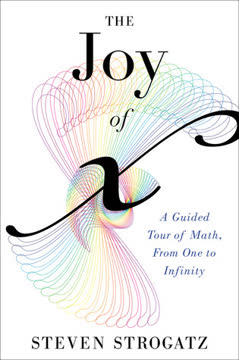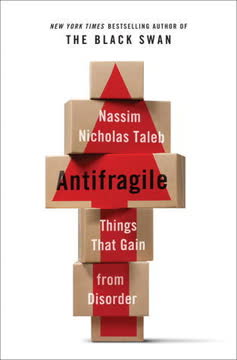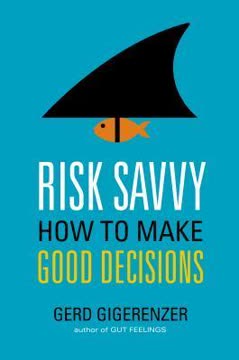Key Takeaways
1. Understand the difference between risk and uncertainty
Risk is when you know the odds. Uncertainty is when you don't.
Risk vs. Uncertainty: Risk involves known probabilities, like in games of chance, while uncertainty deals with unknown probabilities in real-world situations. Understanding this distinction is crucial for making informed decisions.
Implications: In a world of risk, statistical thinking and logic suffice. However, in uncertain situations, intuition and smart rules of thumb become essential. Many real-world scenarios, from financial markets to medical decisions, involve uncertainty rather than calculable risks.
The Turkey Illusion: Beware of treating uncertainty as if it were risk. This "turkey illusion" can lead to false confidence and poor decisions, as demonstrated by financial models that failed to predict the 2008 crisis.
2. Learn to interpret statistics and probabilities correctly
Always ask: What is the absolute risk increase?
Relative vs. Absolute Risk: Relative risk figures can be misleading. For example, a "100% increase" in risk might only mean an absolute increase from 1 in 10,000 to 2 in 10,000.
Natural Frequencies: Present probabilities as natural frequencies to improve understanding. Instead of saying "30% chance of rain," say "It will rain on 30 out of 100 days like this."
Key points for better statistical understanding:
- Ask for the reference class: "Percent of what?"
- Convert probabilities to natural frequencies
- Look for absolute risk changes, not just relative ones
- Be wary of survival rates in medical contexts
3. Beware of defensive decision-making and conflicts of interest
SIC syndrome: Self-defense, Innumeracy, and Conflicts of interest.
Defensive Decision-Making: This occurs when individuals or organizations choose a suboptimal option to protect themselves from potential blame or litigation. It's prevalent in medicine, finance, and management.
Conflicts of Interest: Many professionals, especially in healthcare and finance, face conflicts between their own interests and those of their clients or patients.
Consequences:
- Unnecessary medical tests and treatments
- Financial advice that benefits advisors more than clients
- Reduced innovation and risk-taking in organizations
4. Recognize the power of simple rules in complex situations
Make everything as simple as possible, but not simpler.
Less is More: In uncertain environments, simple rules often outperform complex models. Examples include the 1/N rule for investment diversification and fast-and-frugal trees for medical diagnosis.
Why Simple Works: Simple rules:
- Reduce overfitting to past data
- Are more robust to changes in the environment
- Can be easily understood and applied
Applications:
- Financial investing: Equal allocation (1/N) strategy
- Medical diagnosis: Ottawa Ankle Rules
- Disaster response: Simple triage rules
5. Develop risk literacy to make better health decisions
No decision about me without me.
Understanding Medical Tests: Learn to interpret test results correctly. A positive result doesn't always mean you have a disease, and a negative result doesn't guarantee you don't.
Screening Dilemmas: Understand the benefits and harms of screening tests. For example, PSA testing for prostate cancer and mammography for breast cancer have both benefits and potential harms.
Key concepts:
- False positives and false negatives
- Overdiagnosis and overtreatment
- The difference between relative and absolute risk reduction
6. Navigate financial risks with informed strategies
Don't buy financial products you don't understand.
Financial Literacy: Develop basic financial knowledge to avoid common pitfalls and make informed decisions.
Investment Strategies:
- Consider simple diversification strategies like 1/N
- Be wary of complex financial products
- Understand the limitations of expert predictions
Risk Management:
- Don't confuse uncertainty with calculable risk in finance
- Be cautious of high leverage ratios
- Recognize the potential for systemic risks in the financial system
7. Foster a positive error culture for innovation and safety
A system that makes no errors is not intelligent.
Positive Error Culture: Encourage open discussion of errors to learn from them and improve systems. This approach is crucial in fields like aviation and should be adopted more widely in healthcare.
Good vs. Bad Errors:
- Good errors: Lead to learning and innovation
- Bad errors: Result from carelessness or willful ignorance
Implementation:
- Use checklists and protocols to reduce preventable errors
- Create systems for reporting and analyzing errors without blame
- Celebrate learning from mistakes rather than punishing them
8. Embrace uncertainty in relationships and personal choices
Throw a coin but don't look at the result.
Decision-Making in Relationships: Recognize that many personal decisions involve uncertainty rather than calculable risks. Intuition and simple rules often work better than complex analyses.
Strategies for Personal Choices:
- Satisficing: Choose the first option that meets your criteria
- Social imitation: Learn from others' experiences
- Trust your gut feelings, but know when to question them
Balancing Analysis and Intuition: In matters of the heart, sometimes flipping a coin can reveal your true feelings more than prolonged analysis.
9. Critically evaluate screening tests and medical interventions
If you haven't had a mammogram, you need more than your breasts examined.
Screening Paradoxes: Understand that early detection doesn't always save lives and can lead to overdiagnosis and overtreatment.
Evaluating Medical Evidence:
- Look for absolute risk reductions, not just relative ones
- Consider both benefits and harms of interventions
- Be aware of lead time bias and overdiagnosis in cancer screening
Informed Decision-Making: Use fact boxes and icon arrays to understand the true benefits and risks of medical interventions. Don't be swayed by emotional appeals or incomplete information.
10. Teach risk literacy early to empower future generations
Everyone can learn to deal with risk and uncertainty.
Early Education: Introduce concepts of risk, probability, and decision-making in schools, starting from an early age.
Curriculum Components:
- Statistical thinking and data interpretation
- Understanding of heuristics and biases
- Real-world problem-solving using risk concepts
Benefits: A risk-literate population can:
- Make better personal health and financial decisions
- Understand and participate in public policy debates
- Navigate the complexities of the modern world more effectively
Last updated:
FAQ
What's Risk Savvy: How to Make Good Decisions about?
- Focus on Decision Making: The book explores how individuals can make better decisions in uncertain situations by understanding risk and probability.
- Critique of Expert Reliance: Gerd Gigerenzer argues against sole reliance on experts, advocating for personal risk understanding and intuition.
- Practical Applications: It provides tools and rules of thumb for decision-making in contexts like finance and healthcare.
Why should I read Risk Savvy: How to Make Good Decisions?
- Enhance Decision-Making Skills: The book equips you with knowledge to make informed decisions, especially in uncertain situations.
- Understand Risk Literacy: It highlights the importance of risk literacy in navigating complex information and potential pitfalls.
- Real-World Examples: Engaging anecdotes and case studies make complex concepts relatable and applicable.
What are the key takeaways of Risk Savvy: How to Make Good Decisions?
- Risk Literacy is Essential: Understanding risks is as crucial as traditional literacy in today’s society.
- Simple Rules Over Complex Models: Simple rules of thumb can often outperform complex models in uncertain environments.
- Intuition Matters: Trusting informed gut feelings can play a significant role in decision-making.
What are the best quotes from Risk Savvy: How to Make Good Decisions and what do they mean?
- “Knowledge is the antidote to fear.”: Understanding risks can alleviate anxiety and lead to better decision-making.
- “Always ask for the reference class: Percent of what?”: Highlights the importance of context in interpreting probabilities.
- “If you can get me to offer you $5,000 not to open the door, take the money and go home.”: Emphasizes minimizing potential losses in uncertain situations.
What is risk literacy as defined in Risk Savvy: How to Make Good Decisions?
- Basic Knowledge Requirement: It involves understanding probabilities, risks, and decision implications.
- Avoiding Manipulation: Educated citizens can protect themselves from misleading statistics and poor choices.
- Educational Gaps: The book points out the lack of risk literacy education in schools.
How does Gerd Gigerenzer suggest we communicate risks effectively in Risk Savvy: How to Make Good Decisions?
- Use Natural Frequencies: Present risks in natural frequencies rather than conditional probabilities for better understanding.
- Clarify Reference Classes: Specify the reference class when discussing probabilities to avoid confusion.
- Simplify Information: Clear communication enhances understanding and decision-making.
What is the Monty Hall problem and its significance in Risk Savvy: How to Make Good Decisions?
- Game Show Scenario: Involves choosing between three doors, illustrating probability misunderstandings.
- Probability Confusion: Many mistakenly believe switching doors offers no advantage, though it increases winning chances.
- Teaching Tool: Highlights the importance of understanding risk in uncertain situations.
How does Risk Savvy: How to Make Good Decisions address the concept of defensive decision-making?
- Fear of Responsibility: Defensive decisions are made to avoid blame, leading to suboptimal choices.
- Cultural Implications: A culture of fear stifles innovation and risk-taking.
- Real-World Examples: Examples from industries like medicine illustrate how defensive decision-making hinders progress.
What role does intuition play in decision-making according to Risk Savvy: How to Make Good Decisions?
- Unconscious Intelligence: Intuition is based on experience and rules of thumb, allowing quick decisions.
- Trusting Gut Feelings: Encourages trusting instincts informed by past experiences.
- Balancing Intuition and Reasoning: Both intuition and rational thought are necessary for effective decision-making.
What is the SIC syndrome mentioned in Risk Savvy: How to Make Good Decisions?
- Definition of SIC Syndrome: Combines defensive medicine, innumeracy, and conflicts of interest in healthcare.
- Impact on Patients: Leads to overtreatment and misinformed patients due to unnecessary procedures.
- Call for Change: Advocates for training medical professionals in risk communication and statistical reasoning.
What is the Turkey Illusion as described in Risk Savvy: How to Make Good Decisions?
- Definition of Turkey Illusion: Misconception that risks can be precisely calculated, leading to false certainty.
- Historical Context: Uses a turkey's fate as a metaphor for perceived safety being misleading.
- Implications for Decision-Making: Encourages skepticism of complex models and simpler decision-making strategies.
How can I apply the principles from Risk Savvy: How to Make Good Decisions in my daily life?
- Practice Risk Literacy: Question statistics and probabilities, seeking context and clarification.
- Use Simple Rules: Implement rules of thumb like the 1/N rule for investments to streamline decisions.
- Trust Your Intuition: Recognize when gut feelings are based on experience and balance them with rational analysis.
Review Summary
Risk Savvy explores decision-making under uncertainty, advocating for simple heuristics over complex models. Gigerenzer critiques medical screening practices and financial advice, emphasizing the importance of understanding statistics and probabilities. Readers find the book insightful, praising its accessible explanations of risk assessment and decision-making strategies. Some criticize its structure and repetitiveness, while others appreciate its challenge to conventional wisdom. The book's emphasis on empowering individuals to make informed decisions resonates with many, though some find certain sections less compelling or biased against specific industries.
Similar Books










Download PDF
Download EPUB
.epub digital book format is ideal for reading ebooks on phones, tablets, and e-readers.







